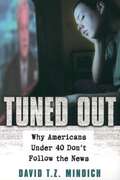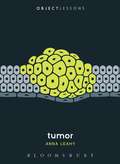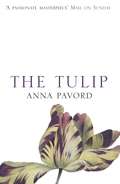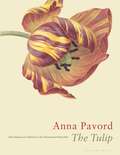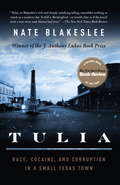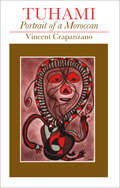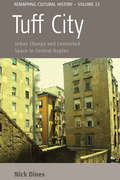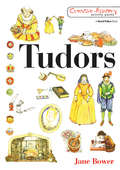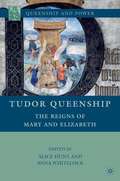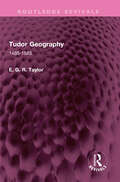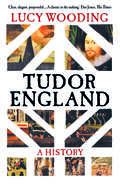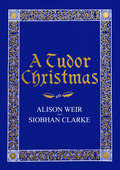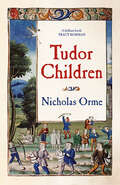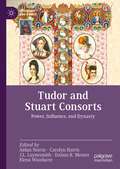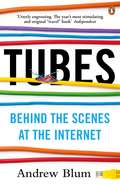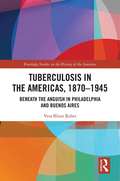- Table View
- List View
Tuned Out: Why Americans Under 40 Don't Follow the News
by David T. MindichAt a rate never before seen in American history, young adults are abandoning traditional news media. Tuned Out: Why Americans Under 40 Don't Follow the News examines the reasons behind this problem and its consequences for American society. Author David T. Z. Mindich speaks directly to young people to discover why some tune in while others tune out--and how America might help them tune back in. Based on discussions with young adults from across the United States, Mindich investigates the decline in news consumption over the past four decades. In 1972, 74% of Americans in their mid-30s said they read a newspaper every day. Today, fewer than 28% do so. The average viewer age at CNN is currently about 60 years old. And while many point to the Internet as the best hope for rekindling interest in the news, only 11% of young people list the news as a major reason for logging on--entertainment, e-mail, and Instant Messenger are ranked far higher on their list. Exploring the political, journalistic, and social consequences of this decrease in political awareness, Mindich poses the question: What are the consequences of two successive generations tuning out? He asserts that as young adults abandon the kinds of news needed to make political decisions, they have unwittingly ceded power to their elders. In an engaged and intelligent way, Mindich outlines these problems and proposes real solutions. An indispensable resource for anyone interested in media or politics, Tuned Out: Why Americans Under 40 Don't Follow the News is also ideal for undergraduate and graduate students in journalism, media, communication, political science, American studies, sociology, and education.
Tumor (Object Lessons)
by Anna LeahyObject Lessons is a series of short, beautifully designed books about the hidden lives of ordinary things. One in two men and one in three women will develop invasive cancer. Tumors have the power to redefine identities and change how people live with one another.Tumor takes readers on an intellectual adventure around the attitudes that shape how humans do scientific research, treat cancer, and talk about disease, treatment, and death. With poetic verve and acuity, Anna Leahy explores why and how tumors happen, how we think and talk about them, and how we try to rid ourselves of them. Object Lessons is published in partnership with an essay series in The Atlantic.
Tumor (Object Lessons)
by Anna LeahyObject Lessons is a series of short, beautifully designed books about the hidden lives of ordinary things. One in two men and one in three women will develop invasive cancer. Tumors have the power to redefine identities and change how people live with one another.Tumor takes readers on an intellectual adventure around the attitudes that shape how humans do scientific research, treat cancer, and talk about disease, treatment, and death. With poetic verve and acuity, Anna Leahy explores why and how tumors happen, how we think and talk about them, and how we try to rid ourselves of them. Object Lessons is published in partnership with an essay series in The Atlantic.
Tumblr (Digital Media and Society)
by Katrin Tiidenberg Crystal Abidin Natalie Ann HendryLaunched in 2007, tumblr became a safe haven for LGBT youth, social justice movements, and a counseling station for mental health issues. For a decade, this micro-blogging platform had more users than either Twitter or Snapchat, but it remained an obscure subculture for nonusers. Katrin Tiidenberg, Natalie Ann Hendry, and Crystal Abidin offer the first systematic guide to tumblr and its crucial role in shaping internet culture. Drawing on a decade of qualitative data, they trace the prominent social media practices of creativity, curation, and community-making, and reveal tumblr’s cultlike appeal and position in the social media ecosystem. The book demonstrates how diverse cultures can – in felt and imagined silos - coexist on a single platform and how destructive recent trends in platform governance are. The concept of “silosociality” is introduced to critically re-think social media, interrogate what kinds of sociality it affords, and what (unintended) consequences arise. This book is an essential resource for students and scholars of media and communication, as well as anyone interested in an influential but overlooked platform.
The Tulip: Twentieth Anniversary Edition
by Anna PavordTHE TULIP is not a gardening book. It is the story of a flower that has made men mad. Greed, desire, anguish and devotion have all played their part in the development of the tulip into the world-wide phenomenon it is today. No other flower has ever carried so much cultural baggage; it charts political upheavals, illuminates social behaviour, mirrors economic booms and busts, plots the ebb and flow of religious persecution. Pavord tells how the tulip arrived from Turkey and took the whole of Western Europe by storm. Sumptuously illustrated from a wide range of sources, this beautifully produced and irresistible volume will become a bible, a unique source book, a universal gift book and a joy to all who possess it.
The Tulip: Twentieth Anniversary Edition
by Anna PavordA twentieth anniversary edition of the classic, featuring new material by the author. Anna Pavord's internationally bestselling sensation, The Tulip, is the story of a flower that has driven men mad. Greed, desire, anguish, and devotion have all played their part in the development of the tulip into a worldwide phenomenon. Today, the United States alone imports three thousand million tulip bulbs each year. No other flower has ever carried so much consequence; it charts political upheavals, illuminates social behavior, mirrors economic booms and busts, plots the ebb and flow of religious persecution. Why did the tulip dominate so many lives through so many centuries in so many countries? Anna Pavord, a self-confessed tulipomaniac, spent six years looking for answers, roaming through Asia, India, and the Ottoman Empire to tell how a humble wildflower of the Asian steppes made its way to Turkey and from there took the whole of Western Europe by storm. Sumptuously illustrated from a wide range of sources, this irresistible volume has become a bible, a unique source book, a universal gift book, and a joy to all who possess it. This beautifully redesigned edition features a new Preface by the author, a completely revised listing of the best varieties of this incomparable flower to choose for your garden, and a reorganized listing of tulip species, to reflect the latest thinking by taxonomists.
Tulia: Race, Cocaine, and Corruption in a Small Texas Town
by Nate BlakesleeThis true story of race and injustice in a small west Texas town "resembles... a modern day To Kill a Mockingbird--or would, that is, if the novel were a true story and Atticus had won" (New York Times Book Review)In the summer of 1999, in the tiny west Texas town of Tulia, thirty-nine people, almost all of them black, were arrested and charged with dealing powdered cocaine. At trial, the prosecution relied almost solely on the uncorroborated, and contradictory, testimony of one police officer. Despite the flimsiness of the evidence against them, virtually all of the defendants were convicted and given sentences as high as ninety-nine years. Winner of the J. Anthony Lukas prize for excellence in nonfiction, Tulia is the story of this town, the bust, the trials, and the heroic legal battle that ultimately led to the reversal of the convictions. But the story is much bigger than the tale of just one bust. As Tulia makes clear, these events are the latest chapter in a story with themes as old as the country itself. It is a gripping, marvelously well-told tale about injustice, race, poverty, hysteria, and desperation in rural America.
Tulia: Race, Cocaine, and Corruption in a Small Texas Town
by Nate BlakesleeThis true story of race and injustice in a small west Texas town "resembles . . . a modern day To Kill a Mockingbird -- or would, that is, if the novel were a true story and Atticus had won" (New York Times Book Review) In the summer of 1999, in the tiny west Texas town of Tulia, thirty-nine people, almost all of them black, were arrested and charged with dealing powdered cocaine. At trial, the prosecution relied almost solely on the uncorroborated, and contradictory, testimony of one police officer. Despite the flimsiness of the evidence against them, virtually all of the defendants were convicted and given sentences as high as ninety-nine years. Winner of the J. Anthony Lukas prize for excellence in nonfiction, Tulia is the story of this town, the bust, the trials, and the heroic legal battle that ultimately led to the reversal of the convictions. But the story is much bigger than the tale of just one bust. As Tulia makes clear, these events are the latest chapter in a story with themes as old as the country itself. It is a gripping, marvelously well-told tale about injustice, race, poverty, hysteria, and desperation in rural America.
Tuhami: Portrait of a Moroccan
by Vincent CrapanzanoTuhami is an illiterate Moroccan tilemaker who believes himself married to a camel-footed she-demon. A master of magic and a superb story-teller, Tuhami lives in a dank, windowless hovel near the kiln where he works. Nightly he suffers visitations from the demons and saints who haunt his life, and he seeks, with crippling ambivalence, liberation from 'A'isha Qandisha, the she-demon. In a sensitive and bold experiment in interpretive ethnography, Crapanzano presents Tuhami's bizarre account of himself and his world. In so doing, Crapanzano draws on phenomenology, psychoanalysis, and symbolism to reflect upon the nature of reality and truth and to probe the limits of anthropology itself. Tuhami has become one of the most important and widely cited representatives of a new understanding of the whole discipline of anthropology.
Tuhami: Portrait of a Moroccan
by Vincent CrapanzanoTuhami is an illiterate Moroccan tilemaker who believes himself married to a camel-footed she-demon. A master of magic and a superb story-teller, Tuhami lives in a dank, windowless hovel near the kiln where he works. Nightly he suffers visitations from the demons and saints who haunt his life, and he seeks, with crippling ambivalence, liberation from 'A'isha Qandisha, the she-demon. In a sensitive and bold experiment in interpretive ethnography, Crapanzano presents Tuhami's bizarre account of himself and his world. In so doing, Crapanzano draws on phenomenology, psychoanalysis, and symbolism to reflect upon the nature of reality and truth and to probe the limits of anthropology itself. Tuhami has become one of the most important and widely cited representatives of a new understanding of the whole discipline of anthropology.
Tuhami: Portrait of a Moroccan
by Vincent CrapanzanoTuhami is an illiterate Moroccan tilemaker who believes himself married to a camel-footed she-demon. A master of magic and a superb story-teller, Tuhami lives in a dank, windowless hovel near the kiln where he works. Nightly he suffers visitations from the demons and saints who haunt his life, and he seeks, with crippling ambivalence, liberation from 'A'isha Qandisha, the she-demon. In a sensitive and bold experiment in interpretive ethnography, Crapanzano presents Tuhami's bizarre account of himself and his world. In so doing, Crapanzano draws on phenomenology, psychoanalysis, and symbolism to reflect upon the nature of reality and truth and to probe the limits of anthropology itself. Tuhami has become one of the most important and widely cited representatives of a new understanding of the whole discipline of anthropology.
Tuhami: Portrait of a Moroccan
by Vincent CrapanzanoTuhami is an illiterate Moroccan tilemaker who believes himself married to a camel-footed she-demon. A master of magic and a superb story-teller, Tuhami lives in a dank, windowless hovel near the kiln where he works. Nightly he suffers visitations from the demons and saints who haunt his life, and he seeks, with crippling ambivalence, liberation from 'A'isha Qandisha, the she-demon. In a sensitive and bold experiment in interpretive ethnography, Crapanzano presents Tuhami's bizarre account of himself and his world. In so doing, Crapanzano draws on phenomenology, psychoanalysis, and symbolism to reflect upon the nature of reality and truth and to probe the limits of anthropology itself. Tuhami has become one of the most important and widely cited representatives of a new understanding of the whole discipline of anthropology.
Tuff City: Urban Change and Contested Space in Central Naples (Remapping Cultural History #13)
by Nick DinesDuring the 1990s, Naples’ left-wing administration sought to tackle the city’s infamous reputation of being poor, crime-ridden, chaotic and dirty by reclaiming the city’s cultural and architectural heritage. This book examines the conflicts surrounding the reimaging and reordering of the city’s historic centre through detailed case studies of two piazzas and a centro sociale, focusing on a series of issues that include heritage, decorum, security, pedestrianization, tourism, immigration and new forms of urban protest. This monograph is the first in-depth study of the complex transformations of one of Europe’s most fascinating and misunderstood cities. It represents a new critical approach to the questions of public space, citizenship and urban regeneration as well as a broader methodological critique of how we write about contemporary cities.
Tudors
by Jane BowerThe innovative Creative History Activity Packs series is designed to help teachers bring history topics to life through imaginative creative arts activities. Each pack includes ten laminated, double-sided cards, printed in full color. Each card describes in detail activities that recreate aspects of life in a particular historical period, using art, drama and dance. Each activity is based on historically researched authentic practices of the time. Ideal for whole class or small group sessions, the packs are an inspiration for busy teachers looking for new ways to approach project work at Key Stage 2 - and are easily applicable for Key Stage 1 classes. Tudor activities in this pack include creating clove pomanders and soap balls; painting miniatures to mount as jewelry; making your own ink and writing a Tudor menu; making a miniature book for herbs, recipes or prayers; Tudor recipe ideas; and structured outlines for drama and dance.
Tudors
by Jane BowerThe innovative Creative History Activity Packs series is designed to help teachers bring history topics to life through imaginative creative arts activities. Each pack includes ten laminated, double-sided cards, printed in full color. Each card describes in detail activities that recreate aspects of life in a particular historical period, using art, drama and dance. Each activity is based on historically researched authentic practices of the time. Ideal for whole class or small group sessions, the packs are an inspiration for busy teachers looking for new ways to approach project work at Key Stage 2 - and are easily applicable for Key Stage 1 classes. Tudor activities in this pack include creating clove pomanders and soap balls; painting miniatures to mount as jewelry; making your own ink and writing a Tudor menu; making a miniature book for herbs, recipes or prayers; Tudor recipe ideas; and structured outlines for drama and dance.
Tudor Queenship: The Reigns of Mary and Elizabeth (Queenship and Power)
by Alice Hunt & Anna WhitelockThis book brings together a selection of recent, cutting-edge research which, for the first time, challenges commonplace arguments about Mary and Elizabeth's relative successes or failures in order to rethink Tudor queenship.
Tudor Geography: 1485-1583 (Routledge Revivals)
by E. G. TaylorFirst published in 1930, Tudor Geography discusses the men and the geographical concepts that enabled world-famous voyages by the British with the aim of circumventing Spanish and Portuguese monopoly of the direct routes to the Spice Islands. The book throws light on a new facet of a fateful century during which Englishmen of all ranks were forced gradually, by circumstances, to think geographically as they had never done before. This book will be of interest to students of history and geography.
Tudor Geography: 1485-1583 (Routledge Revivals)
by E. G. TaylorFirst published in 1930, Tudor Geography discusses the men and the geographical concepts that enabled world-famous voyages by the British with the aim of circumventing Spanish and Portuguese monopoly of the direct routes to the Spice Islands. The book throws light on a new facet of a fateful century during which Englishmen of all ranks were forced gradually, by circumstances, to think geographically as they had never done before. This book will be of interest to students of history and geography.
Tudor England: A History
by Lucy WoodingA compelling, authoritative account of the brilliant, conflicted, visionary world of Tudor England When Henry VII landed in a secluded bay in a far corner of Wales, it seemed inconceivable that this outsider could ever be king of England. Yet he and his descendants became some of England’s most unforgettable rulers, and gave their name to an age. The story of the Tudor monarchs is as astounding as it was unexpected, but it was not the only one unfolding between 1485 and 1603. In cities, towns, and villages, families and communities lived their lives through times of great upheaval. In this comprehensive new history, Lucy Wooding lets their voices speak, exploring not just how monarchs ruled but also how men and women thought, wrote, lived, and died. We see a monarchy under strain, religion in crisis, a population contending with war, rebellion, plague, and poverty. Remarkable in its range and depth, Tudor England explores the many tensions of these turbulent years and presents a markedly different picture from the one we thought we knew.
A Tudor Christmas
by Alison Weir Siobhan ClarkeChristmas in Tudor times was a period of feasting, revelry and merrymaking ‘to drive the cold winter away’. A carnival atmosphere presided at court, with a twelve-day-long festival of entertainments, pageants, theatre productions and ‘disguisings’, when even the king and queen dressed up in costume to fool their courtiers. Throughout the festive season, all ranks of subjects were freed for a short time from everyday cares to indulge in eating, drinking, dancing and game-playing.We might assume that our modern Christmas owes much to the Victorians. In fact, as Alison Weir and Siobhan Clarke reveal in this fascinating book, many of our favourite Christmas traditions date back much further. Carol-singing, present-giving, mulled wine and mince pies were all just as popular in Tudor times, and even Father Christmas and roast turkey dinners have their origins in this period. The festival was so beloved by English people that Christmas traditions survived remarkably unchanged in this age of tumultuous religious upheaval.Beautifully illustrated with original line drawings throughout, this enchanting compendium will fascinate anyone with an interest in Tudor life – and anyone who loves Christmas.
Tudor Children
by Nicholas OrmeThe first history of childhood in Tudor England What was it like to grow up in England under the Tudors? How were children cared for, what did they play with, and what dangers did they face? In this beautifully illustrated and characteristically lively account, leading historian Nicholas Orme provides a rich survey of childhood in the period. Beginning with birth and infancy, he explores all aspects of children’s experiences, including the games they played, such as Blind Man’s Bluff and Mumble-the-Peg, and the songs they sang, such as “Three Blind Mice” and “Jack Boy, Ho Boy.” He shows how social status determined everything from the food children ate and the clothes they wore to the education they received and the work they undertook. Although childhood and adolescence could be challenging and even hazardous, it was also, as Nicholas Orme shows, a treasured time of learning and development. By looking at the lives of Tudor children we can gain a richer understanding of the era as a whole.
Tudor and Stuart Consorts: Power, Influence, and Dynasty (Queenship and Power)
by Aidan Norrie Carolyn Harris J. L. Laynesmith Danna R. Messer Elena WoodacreThis book examines the lives and tenures of all the consorts of the Tudor and Stuart monarchs of England between 1485 and 1714, as well as the wives of the two Lords Protector during the Commonwealth. The figures in Tudor and Stuart Consorts are both incredibly familiar—especially the six wives of Henry VIII—and exceedingly unfamiliar, such as George of Denmark, the husband of Queen Anne. These innovative and authoritative biographies recognise the important role consorts played in a period before constitutional monarchy: in addition to correcting popular assumptions that are based on limited historical evidence, the chapters provide a fuller picture of the role of consort that goes beyond discussions of exceptionalism and subversion. This volume and its companions reveal the changing nature of English consortship from the Norman Conquest to today.
Tubes: Behind the Scenes at the Internet
by Andrew BlumThe Internet. Home to the most important and intimate aspects of our lives. Our careers, our relationships, our selves, all of them are out there - online. So ... where is that exactly? And who's in charge again? And what if it breaks?In Tubes Andrew Blum takes us on a gripping backstage tour of the real but hidden world of the Internet, introducing us to the remarkable clan of insiders and eccentrics who own, design and run it everyday. He uncovers the secret data warehouses where our online selves are stored, peels back the wires that transport us across the globe, reveals its mammoth hubs and surprising alley-ways, explaining what the Internet actually is, where it is, how it got there - and, yes, what happens when it breaks.
Tuberculosis in the Americas, 1870-1945: Beneath the Anguish in Philadelphia and Buenos Aires
by Vera Blinn ReberThis book focuses on the era during which the cause of tuberculosis had been identified, and public health officials were seeking to prevent it, but scientists had not yet found a cure. By examining tuberculosis comparatively in two Atlantic port cities, Buenos Aires and Philadelphia, it explores the medical, political and economic settings in which patients, physicians and urban officials lived and worked. Reber discusses the causes of tuberculosis, treatments and public health efforts to stop contagion, and how factors such as gender, age, class, nationality, beliefs and previous experiences shaped patient responses, and often defined the type of treatment.
Tuberculosis in the Americas, 1870-1945: Beneath the Anguish in Philadelphia and Buenos Aires
by Vera Blinn ReberThis book focuses on the era during which the cause of tuberculosis had been identified, and public health officials were seeking to prevent it, but scientists had not yet found a cure. By examining tuberculosis comparatively in two Atlantic port cities, Buenos Aires and Philadelphia, it explores the medical, political and economic settings in which patients, physicians and urban officials lived and worked. Reber discusses the causes of tuberculosis, treatments and public health efforts to stop contagion, and how factors such as gender, age, class, nationality, beliefs and previous experiences shaped patient responses, and often defined the type of treatment.
